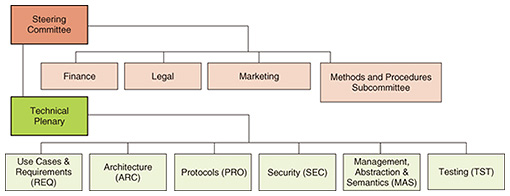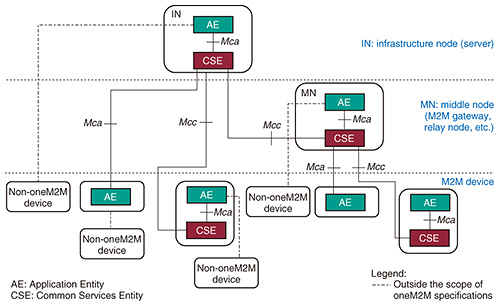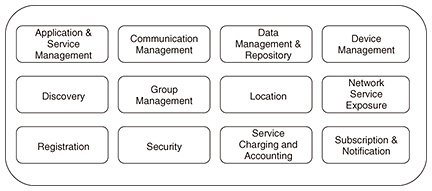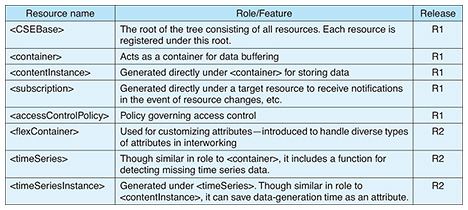 |
|||||||||||||||||||
|
|
|||||||||||||||||||
|
Global Standardization Activities Vol. 16, No. 4, pp. 57–61, Apr. 2018. https://doi.org/10.53829/ntr201804gls Standardization Trends of oneM2M for Horizontal Internet of Things PlatformAbstractThe oneM2M partnership project was founded to promote the standardization of a horizontal Internet of Things (IoT) platform. The aim is to establish specifications for a functional group that can be used in common by many IoT systems as a platform, while also formulating specifications for interworking with other existing standards. This article introduces the overall organization and specifications of oneM2M and reports some recent trends. Keywords: IoT, horizontal IoT platform, oneM2M 1. Overview of oneM2M organizationThe oneM2M organization was founded in 2012 in order to avoid having an overabundance of standards for Internet of Things (IoT) platforms and to promote the drafting of specifications for a horizontal IoT platform. It was formed as a partnership project by seven standards development organizations (SDOs) in Europe, the United States, Japan, China, and Korea, including the European Telecommunications Standards Institute (ETSI), the Association of Radio Industries and Businesses (ARIB), and the Telecommunication Technology Committee (TTC). Now, with the addition of Telecom Standards Development Society, India (TSDSI) in 2015, oneM2M is managed by eight regional SDOs as Partner Type 1 organizations. In addition, members selected by Partner Type 1 organizations form a Steering Committee that oversees a Technical Plenary followed by six Working Groups (Fig. 1). Technical discussions related to oneM2M specifications are held at six face-to-face meetings every year and in conference calls conducted between those meetings.
Release 1 and Release 2 of oneM2M specifications were released in May 2015 and August 2016, respectively. As of this writing, Release 3 is scheduled for March 2018. 2. Basis specifications in Release 1The oneM2M specifications are divided into two levels: high-level architecture independent of communication methods and specific lower-level communication methods [1, 2]. An overview of this architecture is shown in Fig. 2. Here, entities related to communications include an Application Entity (AE), which represents an application, and a Common Services Entity (CSE), which is a collection of common functions in the IoT system. Also specified are reference points between these entities such as Mca (between CSE and AE) and Mcc (between CSE and CSE). In this architecture, CSEs are deployed at the cloud, edge, gateways and other areas and are interconnected in a tree structure. An AE operates in conjunction with one of these CSEs. It can also exchange messages with a CSE to which it is not directly connected by routing via other CSEs.
A CSE is a collection of common functions required by many IoT systems. There are 12 types of functions in all, including those for data management, device management, and security (Fig. 3). These functions are expressed as resources to enable external use through resource operations performed via an external AE or CSE. Resource operations have been narrowed down to CREATE, RETRIEVE, UPDATE, DELETE, and NOTIFY. Using only five operations in this way achieves a simpler protocol design than a web service, in which developers can define any operations.
Multiple types of oneM2M resources have been specified such as <contentInstance> for storing sensing data, <container> for storing those instances, and <subscription> for receiving notifications of information updates. The main types of resources are listed in Table 1.
Specific communication methods used under the above architecture can be selected from a variety of protocols and message encoding schemes (called serialization). Release 1 of oneM2M allows for protocol selection from HTTP (Hypertext Transfer Protocol), CoAP (Constrained Application Protocol), and MQTT (Message Queue Telemetry Transport) and serialization from XML (Extensible Markup Language) and JSON (JavaScript Object Notation). This approach enables the selection of a communication method appropriate to requirements at the time of system development while simplifying migration in the event that a superior communication method becomes available in the future. In addition, oneM2M provides a framework for linking to and operating with other standard protocols [3–6]. A type of AE called an Interworking Proxy Application Entity (IPE) can communicate with another standard protocol. An IPE creates a resource on CSE as reflecting information on the other protocol so that other AEs on oneM2M can read that information. Conversely, the IPE can monitor for resource updates performed by oneM2M AEs and notify and interact with the other standard protocol accordingly. In short, an IPE enables oneM2M to link up with another standard protocol. 3. Extensions in Release 2 and Release 3In this section, we describe the main elements included in these releases. 3.1 Release 2Release 2 of oneM2M contained specifications for the home and industrial domains and for interworking, and it introduced semantics technology. Specifications for the home domain included an information model for home appliances. Specifications for the industrial domain introduced the <timeSeries> and <timeSeriesInstance> resources for handling time series data. In addition, more options for communication methods were added to enable high-immediacy communications and more efficient communications. Specifically, Websocket was added as a protocol, and CBOR (Concise Binary Object Representation) was added as a binary format for serialization. Release 2 also presented interworking specifications with AllJoyn, OIC (Open Interconnect Consortium), and LwM2M (Lightweight M2M) and introduced the <flexContainer> resource to enable efficient representation of diverse types of data. In terms of semantics technology, Release 2 introduced the <semanticDescriptor> resource that enables the meaning of data to be described using RDF (Resource Description Framework). This information can be used to search for resources. 3.2 Release 3Scheduled for release in March 2018, Release 3 is focused on efforts to promote the adoption of oneM2M. Thus, key items—a developer’s guide and test specifications—have been revised and improved. Release 3 also includes more extensions to home-domain specifications. Of these, interworking between oneM2M and healthcare devices specified by OMA GotAPI* (DeviceWebAPI) was approved. Specifically, a data model for representing target devices on oneM2M was added, and its correspondence with the data model on the OMA side was specified. These additions to oneM2M specifications were achieved through a collaborative effort among NTT Network Innovation Laboratories, NTT Service Evolution Laboratories, and NTT DOCOMO.
4. Trends surrounding oneM2MWe introduce here three major trends surrounding oneM2M: interoperability test events, certification, and open source software (OSS). 4.1 Interoperability test eventAn interoperability test event is an event in which each company brings its own implementation and conducts interoperability tests. This is an open event lasting about four or five days, and even non-oneM2M members can participate. It has been held twice a year since 2015. In this event, a participant performs an interoperability test with a predetermined partner according to oneM2M test specifications [7] in a session lasting one to two hours. This session is repeated about four times a day. Taking part in this event enables a participant to efficiently improve the quality of its implementation. It also enables discrepancies with or ambiguities in oneM2M specifications to be identified and mutual operability to be verified. NTT has participated in all five past events. 4.2 CertificationCertification is an activity that assesses (through testing) whether a product complies with standards and specifications and if so, gives permission to display that fact. Being a partnership project, oneM2M is not a corporate entity, so it itself cannot act as a certification body. It has therefore been decided to consign the work of certification to an outside institution. Several discussions have been held with regard to this matter, and with an eye to commencing oneM2M certification as early as possible, it was agreed in April 2016 that certification work would be rolled out in stages beginning with regional certification (Phase 1) followed by global certification (Phase 2). Taking the lead in Phase 1, Korea’s Telecommunication Technology Association (TTA) began certification activities targeting Asia in February 2017. As of December 2017, 11 products of 8 companies had been certified. Global certification targeting the entire world as Phase 2 is scheduled to begin in the middle of 2018 using the Global Certification Forum (GCF) in the United Kingdom as the certification body. 4.3 OSSImplementations of oneM2M through OSS projects are also progressing. Some examples of CSE implementations are OM2M of the Eclipse project, Mobius of the OCEAN project, and IoTDM of the OpenDaylight project. In addition, OS-IoT promoted by the Alliance for Telecommunications Industry Solutions (ATIS) is a software library for developing AEs for embedded devices. 5. Future plansAt the time of this writing, Release 3 of oneM2M was scheduled for release in March 2018. In addition, procedures for transposition of oneM2M specifications as the International Telecommunication Union - Telecommunication Standardization Sector (ITU-T) Recommendations are proceeding, and the plan is to reach a consensus in this regard in ITU-T Study Group 20. This endorsement as ITU-T Recommendations should further advance the awareness and spread of oneM2M. The formulation of oneM2M Release 4 specifications will begin in earnest following the release of Release 3. As of December 2017, improving access control and simplifying the oneM2M platform had been approved as items to be taken up. It is also being proposed that more attention should be given to the smart city domain [8] as an application of oneM2M, in view of the high affinity of this field with the oneM2M platform. NTT Network Innovation Laboratories considers oneM2M to be promising as an IoT platform standard. Going forward, it plans to make contributions and proposals and lobby the oneM2M partnership project with the aim of making oneM2M into specifications that can be effectively used by the NTT Group. References
Trademark notesAll brand names, product names, and company names that appear in this article are trademarks or registered trademarks of their respective owners. |
|||||||||||||||||||







